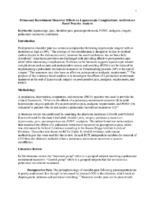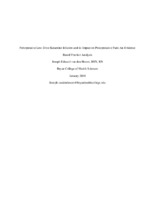| dc.contributor.advisor | Pecka, Shannon | en |
| dc.contributor.author | Feighny, Michael | en |
| dc.date.accessioned | 2017-06-26T17:24:48Z | |
| dc.date.available | 2017-06-26T17:24:48Z | |
| dc.date.issued | 2017-06-26 | |
| dc.identifier.uri | http://hdl.handle.net/10755/621596 | |
| dc.description.abstract | <p>Postoperative shoulder pain is a common complication following laparoscopic surgery with an incidence as high as 80%.<span style="font-family: TimesNewRomanPSMT; font-size: xx-small;">1</span> The etiology of the shoulder pain is thought to be due to residual carbon dioxide in the abdominal cavity, however the exact mechanism has not been fully elucidated.<span style="font-family: TimesNewRomanPSMT; font-size: xx-small;"><span style="font-family: TimesNewRomanPSMT; font-size: xx-small;">2 </span></span><span style="font-family: TimesNewRomanPSMT;">Anesthesia providers are challenged with providing effective postoperative pain </span>relief while minimizing complications. Evidence in the literature suggests laparoscopic related complications such as pain and postoperative nausea and vomiting (PONV) can be reduced by implementing a pulmonary recruitment maneuver in Trendelenburg position (30°) at the end of surgery.<span style="font-family: TimesNewRomanPSMT; font-size: xx-small;">3 </span> The maneuver may also have an affect on postoperative analgesic requirements.<span style="font-family: TimesNewRomanPSMT; font-size: xx-small;">4,5 </span>The purpose of this evidence-based-analysis is to investigate the effects of a pulmonary recruitment maneuver at the end of laparoscopic surgery on postoperative pain, analgesic requirements, and PONV.</p> | en |
| dc.format | Text-based Document | en |
| dc.language.iso | en | en |
| dc.rights.uri | http://creativecommons.org/licenses/by-nc-nd/4.0/ | * |
| dc.subject | Laparoscopy | en |
| dc.subject | Anesthesia | en |
| dc.subject | Shoulder Pain | en |
| dc.subject | Pneumoperitoneum | en |
| dc.subject | Post-Operative Nausea and Vomiting | en |
| dc.subject | Analgesia | en |
| dc.subject | Pulmonary Recruitment Maneuver | en |
| dc.subject | Surgery | en |
| dc.title | Pulmonary recruitment maneuver effects on laparoscopic complications: An evidence based practice analysis | en |
| dc.type | Other Graduate Paper | en |
| dc.rights.holder | <p>
All rights reserved by the author(s) and/or publisher(s) listed in this item record unless relinquished in whole or part by a rights notation or a Creative Commons License present in this item record.
</p><p>
All permission requests should be directed accordingly and not to the Sigma Repository.
</p><p>
All submitting authors or publishers have affirmed that when using material in their work where they do not own copyright, they have obtained permission of the copyright holder prior to submission and the rights holder has been acknowledged as necessary.
</p> | en |
| thesis.degree.grantor | Bryan College of Health Sciences | en |
| thesis.degree.level | Doctoral – Other | en |
| thesis.degree.year | 2017 | |
| dc.type.category | Full-text | en |
| dc.evidence.level | N/A | en |
| dc.research.approach | N/A | en |
| dc.subject.cinahl | Barotrauma, Pulmonary | en |
| dc.subject.cinahl | Barotrauma, Pulmonary--Prevention and Control | en |
| dc.subject.cinahl | Laparoscopy | en |
| dc.subject.cinahl | Laparoscopy--Adverse Effects | en |
| dc.subject.cinahl | Shoulder Pain | en |
| dc.subject.cinahl | Shoulder Pain--Prevention and Control | en |
| dc.subject.cinahl | Intraoperative Complications | en |
| dc.subject.cinahl | Intraoperative Complications--Prevention and Control | en |
| dc.subject.cinahl | Pneumoperitoneum | en |
| dc.subject.cinahl | Pneumoperitoneum--Therapy | en |
| dc.subject.cinahl | Postoperative Pain | en |
| dc.subject.cinahl | Postoperative Pain--Prevention and Control | en |
| dc.contributor.department | Non-member | en |
| dc.author.details | Michael Feighny, DNAP, CRNA michael.feighny@bryanhealthcollege.edu | en |
| dc.description.reviewtype | Faculty Approved: Degree-based Submission | en |
| dc.description.acquisition | Proxy-submission | en |





